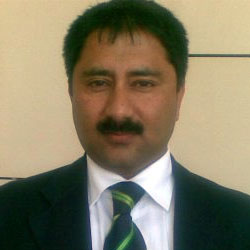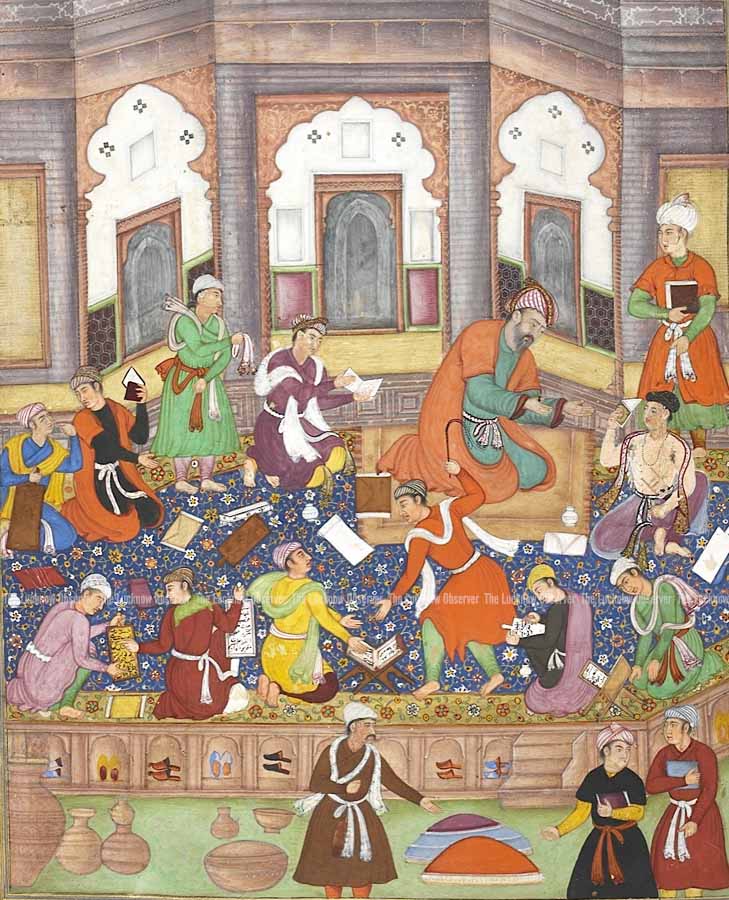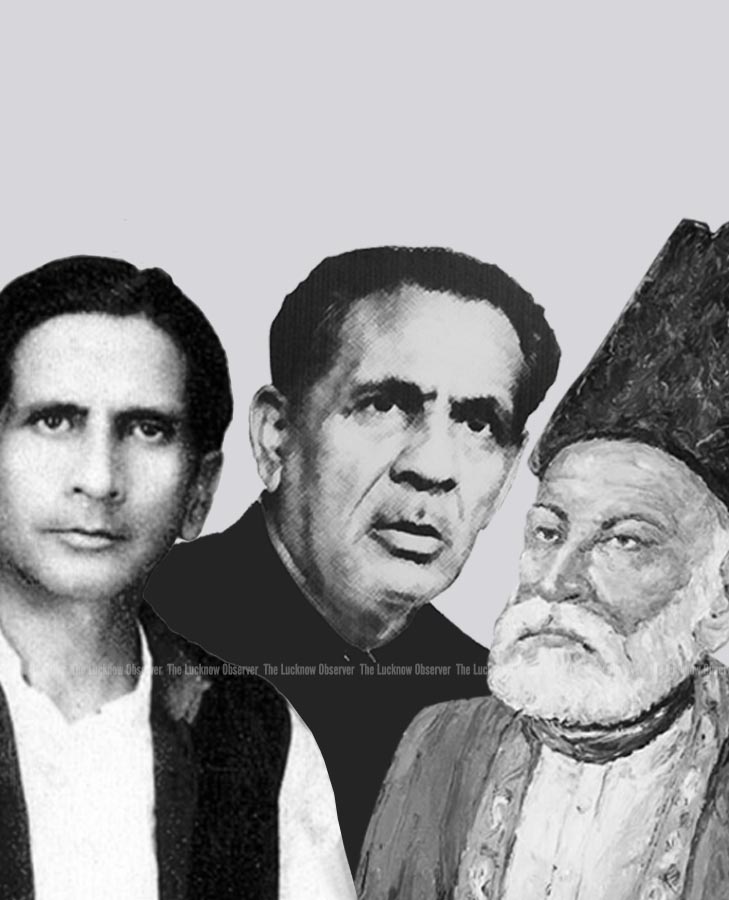Tribute to the wordsmiths of Lucknow
Dilli Jo Ek Shahar Tha Aalam Mein Intekhab
Rehte Thay Jahan Muntakhab Hi Rozgaar Ke

The troubles at Delhi towards the end of eighteenth century and beginning of nineteenth century proved to be a blessing for the people of literary taste at Lucknow, as the ongoing issues on a day-to-day basis and the environment there was not conducive for the men of thoughts and those having seas of expressions thriving in their hearts and minds. The situation developed into a scenario where intellectual migration started to happen and choices were very limited where courts were willing to welcome the poets. Out of possible centres, the main were Hyderabad, Patna and Lucknow. With these choices, Lucknow was not only the nearest in terms of distance but also comparatively secured as both, the court and the people of Lucknow were enthusiastic to embrace the poetic genre looking for solace and the surroundings were fertile. Though, it was realised very early that there was a gulf of differences in the ideology of the poetry of two cities.

The poetry of Lucknow was very particular about the words as compared to Delhi, it gave itself up to external things, such as outward ornament, rather than beauty of thought, whereas Delhi school was very focussed on the subject and thought. Delhi had vigour for style and depth of thought against the verbal accuracy and idiomatic usage prevalent at Lucknow. This alliance resulted in a new blend of rules, language and idioms, restricted poetic license and laid down laws for prosody and figures of speech, specially similes and metaphors. In the desire for power in the use of words, Lucknow increased the length of the lyric and the number of rhymes.

The court of Lucknow being run by the Nawab having Shia faith laid a strong base for those poets who mastered in the art of narration took up the penning of elegies or Marsiya, the poetic description of the tragic events at Karbala. This art was primarily evolved in Persia and was brought to Lucknow purely on religious grounds. In the beginning, these elegies were short devotional poems and little attention was paid to their literary quality. With the passage of time, this form of poetry occupied the vacuum of epic that was not present in the Muslim society.

The epics of Karbala include historic narrative, moral and didactic teaching, description of natural scenery and delineation of human emotion. Lucknow gradually turned out to be a nursery that was to boast of nurturing the raw talent and bring out the best from the future generations who gave Urdu some new dimensions and unparalleled place in the history of literature. Practically it would not be possible to talk about all the poets in one article, however the best of attempt is to highlight the era that gave Lucknow a place and significance in literature.

Here we go through some great names who laid the foundation of poetic mastery at Lucknow during 18th and 19th centuries:
Meer Taqi Meer
Faqeeraana Aaye Sadaa Kar Chalay
Miyaan Khush Raho Hum Dua Kar Chalay
Born in 1723 at Agra, his first visit to Lucknow in 1748 opened the gates of literary fancies for the place and the court of Asaf-ud-Daula extended an invite for him to stay there permanently. However, Meer migrated to Lucknow much later in 1782 to live here until his death in 1810. His Kulliyaat-e-Meer consists of six Deewan and his Masnavi Muamalaat-e-Ishq is one of the greatest known poems in Urdu literature. Basing his language on his native Hindustani, he leavened it with a sprinkling of Persian diction and phraseology, and created a poetic language at once simple, natural and elegant, which was to guide generations of future poets.
Mir Mustahsan Khaliq
The son of Mir Hasan and more famously the father of Mir Anis was one of the earliest elegiac writers in North India. Born in 1774, Khaliq lived until 1804 and during his relatively small life, he took his ability to the heights where on one occasion at his native place, Faizabad, he recited his work with such an effect that Aatish, the legendary of his times, gave up to recite his own lyrics saying that it was not needed when Khaliq was there.
Muzaffar Husain Zamir
A contemporary of Khaliq, Zamir was known better as a pair to former and was a learned man. He is credited to have taken elegies to an advanced level, both in terms of the length as well as the narration. He took into account the battles, the horses, accoutrements and the natural scenery. His works described historical events with a view to increasing religious fervour. He is known for his tough language and fancied style of writings.
Shah Tura’ab Ali Qalandar
The second head of the Sufi Khankhaah (monastery) at Kakori, Shah Tura’ab Ali Qalandar composed marvels in poetry in praise of Lord Krishna. His composition ‘Saant Ras’ is by far considered to be a masterpiece depicting Awadhi language. Falling in line with the philosophy of mysticism, his poetry captured the hearts of those who searched to find the consummation of self. He was one of the first Sufi poets of his times to lay the foundation of communal harmony through the powerful cord of literature.
Karamat Ali Shahidi
He was a native of Bareilly but brought up in Lucknow, he lived a careless life initially but became very religious person during the later course of life. He was known for writing poems in difficult meters. His recorded teachers were Mushafi and Shah Nasir. In one of his odes, Shahidi had expressed his desire to die in Madina and as the destiny had in store, he passed away at Madina during his pilgrimage in the year 1840.
Daya Shankar Kaul Nasim
A native Kashmiri Pandit, Nasim won accolades primarily on his one poem Gulzar-e-Nasim which he wrote at the age of 22. He was a student of Aatish and he is also credited to have presented the earliest Urdu translation of The Arabian Nights. Nasim passed away in the year 1843 at the age of 32.
Haider Ali Aatish
One of the key figures that earned Lucknow a name in Urdu literature that it is today, always remembered for his association with Nasikh, so much so that Aatish gave up writing after the death of Nasikh and he himself passed away in the year 1846. Aatish was a natural poet and used simple, colloquial language, the language of everyday speech. He had a powerful physique and was a swordsman himself. Aatish is considered to be one of the finest Urdu poets had compiled two collections of his poems.
Imam Baksh Nasikh
A contemporary of Aatish, they jointly correspond to the style of Mir and Sauda of earlier generation. Nasikh is regarded as the master of words, he was very fond of using Arabic and Persian words and made minimal use of the local dialects. Nasikh may be credited for making a more common use of the word ‘ghazal’ that was earlier largely practiced as ‘Rekhta’. On the other hand, Nasikh’s poetry is also labelled as bombastic and obscure, that his poetry which was largely influenced by Persian was full of sound and fury but was devoid of poetry.
Agha Hajju Sharf
A pupil of Aatish, Hajju is considered to be one of the torch-bearers of the movement that was against the usage of Persian in Urdu poetry. Abdus Salam and Safir Bilgrami have pointed out that Hajju rejected the whole vocabulary of the wine shop that was prevalent in Urdu Poetry.
Vazir Ali Saba
Another pupil of Aatish, born in 1795 and is credited with his collection of lyrics by the name of ‘Ghuncha-e-Aarzoo’ or a bunch of desires. This collection is known for its idiomatic usage of Urdu.
Muhammad Vazir Vazir
He was a pupil of Nasikh and was regarded as the greatest of the minor poets of his times. He was a very religious man. A contemporary of Saba, his work titled Daftar-i-Fasahat is known for its imagination and subject matter.
Muhammad Khan Rind
Born in 1797 at Faizabad, he lived initial years at his native place before he reached Lucknow. He had so much of influence of Aatish that he destroyed all his works that he compiled during his early years and started from scratch to compile Guldasta-i-Ishq. He took up the religious life during the middle age and passed away in 1857 on the way to Makkah where he was to perform his pilgrimage.
Ali Ausat Rashk
Born in 1799, a pupil of Nasikh, Rashk gave himself up almost entirely to improve the language and laying down rules for it. He was very fond of the colloquial, which he employed freely in his poems. He became a great authority on all points connected with idioms and use of words. He had two collections of poems, namely Nazm-i-Mubarak and Nazm-i- Giraami, the third collection that was said to be the best, was lost. He also compiled Urdu dictionary called Nafs-ul-Lughaat. He passed away in 1867.
Muhammad Riza Barq
A pupil of Nasikh, Barq was fond of far-fetched metaphors and similes, he wrote voluminously as he was attached to the Royal court under Wajid Ali Shah. Barq followed his Royal master into exile and wrote a rather uninspired account of his own loneliness before he died towards the end of 1857.
Hatim Ali Beg Mihr
Born in 1814, Mihr is better known as a correspondent to Ghalib, than for his poetic prowess. Mihr’s biggest achievement refers to Ghalib’s admiration of his work Shuaa-i-Mihr. He is also credited with his collection of poems by the name of Almas-i-Darakhshaan.
Imdaad Ali Bahr
Born in 1810, Bahr was one of the chief disciples of Nasikh, along with Vazir and Rashk. Bahr was a poor man who used to sit on a mat everyday and likeminded people used to visit him and discuss poetry. He was sponsored by the Nawab of Rampur, Kalb Ali Khan who paid him the salary and attached him to the court but Bahr returned to Lucknow out of his own choice.
Ismail Husain Munir
Born in 1819, Munir was a wanderer poet and most famous of his work is Ma’arij-ul- Mazameen, he was a typical poet of his time. The collections of Munir’s poem are titled as Muntakhibat-uI-Aalam, Tanvir-ul-Ash’aar and Nazm-i-Munir. He passed away in the year 1881.
Mahdi Hasan Khan Aabaad
His compiled anthology is known as Baharistan-i-Sukhan and he wrote a great deal of verses. The best known lyrics penned by Aabaad are Nigaristan-i-Ishq.
Wajid Ali Shah Akhtar
All the Nawabs of Lucknow demonstrated their writing abilities but the most prolific among all has been the name of Nawab Wajid Ali Shah during his reign from 1846 to 1856. The poetic description of his exile Huzn-i-Akhtar is a wonderful piece of writing. Some of the unpublished manuscripts of Wajid Ali Shah are still preserved with the British Museum. His last sh’er, penned reportedly upon his departure from Lucknow is often proclaimed as his masterpiece:
Dar-o-Deewar Pe Hasrat Se Nazar Karte
Hain
Khush Raho Ahl-e-Watan, Hum Tu Safar Karte Hain
(At some places, the second misra’a (line) of the couplet is reported as: Rukhsat ! Ahl-e-Watan, Hum Tu Safar Karte Hain)
Muzaffar Ali Khan Aseer
Born in the year 1800, Aseer was one of the courtiers of Nawab Wajid Ali Shah who is known for his articles on grammar and prosody. Aseer also became more famous because of his pupils, namely Ameer Ahmad Minai and Ahmad Ali Shauq. He died in the year 1881.
Mahdi Ali Khan Zaki
He is known for his book on rhyme and prosody titled Yaad Gir, published in 1848. He also authored the short story of Punjab in the year 1850. Zaki is reported to have spent most of his life wandering from one court to another.
Ali Khan Darakhshan
A pupil of Aatish, Shauq is mainly known for his four Masnavi, namely Bahar-i-Ishq, Zahr-i- Ishq, Lazzat-i-Ishq and Fareb-i-Ishq. His works possess an excellent choice of rhymes and enjoyed considerable amount of popularity. Shauq passed away in the year 1871.
Nawab Mirza Shauq
The lineage and family of Munis was itself enough to launch him as a poet but despite being son of Khaliq and brother of Anis, his works left a place for himself and signify his own identity. He had a great command over the language which he showed in his elegies. His power of recitation was far-famed but by and large he remained to be a very religious man and was hardly seen unless he was reciting his elegies at religious gatherings. His works were published in two volumes. Munis passed away in the year 1875.
Sayyid Mirza Ta’ashshuq
He was the son of Mirza Mir Uns and brother of Husain Mirza Ishq, hailing from the literary background his elegies surpassed all others of his time in the pathos which Ta’ashshuq infused. His words well chosen and his ideas were striking despite very ordinary quality of lyrics at times. He passed away in the year 1891.
Husain Mirza Ishq
He was the elder brother of Sayyid Mirza Ta’ashshuq and penned elegies that were published in two volumes. His popularity was con␣ned as he usually did not participate in the public functions and was very much confined to solace. He passed away in the year 1890.
Khursheed Ali Nafis
Descendant of a great lineage, Nafis was the son of great Mir Anis and nephew of Munis. Born in 1819, Nafis had the quality to hold enthralled the audiences which went to hear him recite. He wrote a great deal, but only one small volume has been published. He strongly followed the traditions of the family and passed away at the dawn of twentieth century in 1901.
Mustafa Mirza Rashid
Born in 1845, the son-in-law of the great Mir Anis and nephew of Ishq and Ta’ashshuq, Rashid ventured with writing many love lyrics. He is said to have evolved the style of penning elegies with the description of spring. Rashid chose to adopt the styles of his uncles and managed a reasonable space for him in the literary circuit. He passed away in the year 1917.
Ali Muhammad Aarif
Born in 1861, the grandson of Nafis and great-grandson of Mir Anis, Aarif primarily resembled Nafis in his works, poetic style and character. Having started with love poems, he later on confined to elegies and earned a name for himself. He passed away in the year 1916.
Ameer Minai
Born in 1828 to the family of Maulvi Karam Mohammad Minai, he was a descendant of Sufi Saint Makhdoom Shah Mina of Lucknow. It was not easy for a poet to establish himself in the era of Ghalib and Daagh but Ameer Minai mastered that and not only this but also he was one privileged poet to have witness the times of both Ghalib and Iqbal. He is widely known not only for his poetic prowess but also as a scholar, writer, translator and connoisseur of the Urdu language. His range of study stretched from law to logic and from mathematics to history. He not only penned Ghazal but also Naat, poetic praise of the Prophet Mohammad PBUH. His collections of Ghazal are Meerat-ul- Ghaib and Sanamkhane-e-Ishq, whereas his collections of devotional prose are Khayaabaan-e-Aafreenish and Mahaamid-e-Khatam-un-Nabiyyeen.
The above reference cannot claim to have covered the entire list that contains the men of poetic legacy but it is a nutshell attempt to remember most of them.
At the onset of Twentieth Century
This was the time when Lucknow was at the forefront of the political developments happening all across the country and its impact was all but visible in the literary works of the then poets, writers and authors. Lyrics of love were overshadowed by thoughts of revolution and the sorrows of elegies were crying further with the canvas of religious ideological differences.
The flavour and colours of the poetry that were emerging during the beginning of twentieth century were very different from the previous generation.
The people of Lucknow and surroundings woke up to the new century with very different poetic voices, a great name of Ameer Minai had just passed away at far-off Hyderabad but the later years blessed the city with some of yet another greats like Maulana Syed Fazl-ul-Hasan Hasrat Mohani, Choudhary Jagat Mohan Lal Rawaan, Shabbir Hasan Khan Josh Malihabadi, Brij Narain Chakbast, Asrarul Haq Majaaz, Anand Narain Mulla, Aal-e- Ahmad Suroor, Mohammad Shafi Khan Bekal Utsahi, Ali Sardar Jafri, Waali Aasi, Khumaar Barabankvi, Saghar Khayyami and many more.
The all new breed of poets continued the legacy and despite all the turmoil that was happening during the first half of the century, Urdu poetry continued to flourish with some of the great names and some that could not achieve the much deserved recognition based on their literary acumen.
- Aabaad Lucknowi
- Aal-e-Raza Lucknowi
- Aarzoo Lucknowi
- Abr, Bishan Narain Dar
- Aftaab Lucknowi
- Ahsan Lucknowi
- Aish, Fida Ali
- Asr, Ja’afar Ali Khan
- Asr, Jai Narayan Verma
- Aziz Lucknowi
- Bambuq, Vilayat Ali
- Barq, Jwala Prasad
- Behzad Lucknowi
- Chakbast, Brij Narayan
- Chirkeen, Baaqar Ali
- Dilgeer, Chhannu Lal
- Farhat, Shankar Dayal
- Fasaahat Lucknowi
- Goya, Faqeer Mohammad Khan
- Gulshan, Raja Jiya Lal
- Hairat, Mirza
- Hamid Siddiqui Lucknowi
- Hijr, Bishambhar Nath
- Himmat, Bansi Dhar
- Jadeed Lucknowi
- Jauhar, Munshi Javahir Singh
- Jurrat, Shaikh Qalandar Baksh
- Kamaal, Hakeem Mahdi
- Kashif Lucknowi
- Khanjar Lucknowi
- Khushtar, Jagannath Sahai
- Lataafat Lucknowi
- Maroof, Ilaahi Baksh
- Machis Lucknowi
- Mahshar, Kazim Husain
- Mahvi, Siddiqui Lucknowi
- Mohsin Kakorvi
- Muhazzab Lucknowi
- Munawwar, Bisheshwar Prasad
- Munshi Nawal Kishor
- Munshi Sajjad Husain
- Nawazish Lucknowi
- Nihaal, Chandi Sahai
- Noor, Krishna Bihari
- Qadr, Mirza Sikandar Beg
- Rangeen, Saadat Yaar Khan
- Raunaq, Ram Sahai
- Resh, Sukh Dayal Saxena
- Ruswa, Mirza Muhammad Hadi
- Saabit Lucknowi
- Saahir Lucknowi
- Saaqib Lucknowi
- Saboor, Gopal Sahai
- Sajni, Syed Sajid Ali
- Sarshaar, Ratan Nath
- Shaad, Muhammad Jaan
- Shafaq, Lalta Prasad
- Sharar, Abdul Haleem
- Sitamzareef, Machchhu Beg
- Ufaq, Dwarka Prasad
- Yaas, Zakir Husain
- Zareef Lucknowi
Source : The Lucknow Observer




